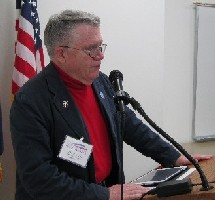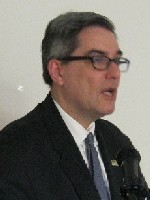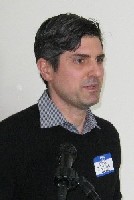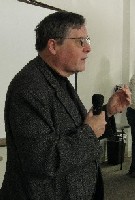
Modern Transportation for the Virginias
Burke Library, Alexandria, Va., March 7
Joint meeting of the Virginia Association of Railway Patrons and the National Association of Railroad Passengers Mid-Atlantic South
Jim Mathews, NARP President & Chief Executive Officer, discussed his plans for the future of the association via a teleconference call from
Asked whether NARP is a supporter of all rail passenger transportation or just intercity rail, Mathews said that, yes, NARP is an advocate for all rail passengers and is a partner with the American Public Transportation Association in Stand Up for Transit Day.
Asked about the “expiring infrastructure” on the Northeast Corridor, Mathews said that NARP continually calls out the underinvestment in infrastructure.
Are NARP chapters active in National Train Day? They have been, said Mathews, though Amtrak, unable to sponsor more than a few events in May, is moving to have many local events throughout the year instead of one National Train Day, and NARP will participate.
What is NARP doing in Congress? NARP is pushing for investment in the long-distance Amtrak network and seeking a public-private partnership for implementing positive train control.
 |
Chuck Riecks of Friends of the Cardinal gave an update on rail passenger service in West Virginia. He said that Friends of the Cardinal are working with Huntington to get a passing siding constructed to take the Cardinal off the mainline during the station stop and crew change. Amtrak is doing work at Prince to bring the station into compliance with the Americans with Disabilities Act. Montgomery is considering building a replica of its historic station. Clifton Forge is looking at moving its station to the historic replica owned by the Chesapeake & Ohio Historical Society.
Riecks noted that the Cardinal had two sleeping cars last summer that routinely sold out. He also said that the Cardinal often sells out between Charlottesville and Washington, so passengers from West Virginia cannot get seats.
He said that Friends of the Cardinal are trying to get West Virginia to contribute funding for the MARC service between Martinsburg and Washington—at present, West Virginia pays nothing.
Riecks said that after the CSX derailment near Montgomery this winter, Friends of the Cardinal assisted local officials by contacting them and giving them railroad information they might not have had. He noted that the tank cars involved in the derailment were a newer type that is supposed to be safer.
Paul Shore commented that the older type of tank cars have thinner walls but can be used to haul non-hazardous cargo.
 |
James Knighton, Director of the Office of Governmental Affairs, Maryland Transit Administration, gave an overview of and update on the red and purple line projects. Both projects, he said, are public-private partnerships, and they share station and railcar design.
He explained that the private partners make their profit from availability payments made to them by the state based on service provided over the life of the project. Maryland is working on a plan to protect small businesses during construction of the lines, he said.
Maryland is also looking for opportunities to piggyback on other cities’ orders for light-rail vehicles. As far as he knows, any railcars that Maryland purchases will be compatible with the existing blue line.
The purple line will run from
The red line will run from the Social Security Administration offices in Woodlawn through West Baltimore and downtown to the Johns Hopkins campus at Bayview. It will be part of Baltimore’s light-rail transit and use the same fare system.
Maryland Governor Hogan changed the bid deadline for the lines’ private partners to August, asking bidders to find ways to reduce Maryland’s financial contribution. There would be no change to the length of the lines or the number of stations.
Noting some opposition to the purple line based on supposedly endangered species, Knighton said that there are no endangered species affected by the purple line as far as the MTA can determine and that the environmental impact studies were already done.
 |
David Zaidain, Union Station Project Director, Amtrak, discussed Washington Union Station redevelopment plans. He said that ridership—regional, Acela, long distance, and commuter—could double by 2040, and much of the infrastructure is over
The air rights were auctioned by Congress in 2006, but Amtrak’s public-private partnership with the developer, Akridge, will integrate development with the station. Amtrak wants to expand the concourse and passenger spaces and increase accessibility for people with disabilities. The project would bring more daylight to the concourse and add a train shed that would be visible from the concourse. People, he said, like to see the trains come and go. The redeveloped station would have new and expanded concourses and move train services such as the commissary to the north end of the platforms.
Phase I construction—restoration of four tracks—might begin later this year. The parking garage would have to be replaced before the current one is demolished.
The next phase would include new platforms and restored tracks on the lower level. Engine changes, he said, are a bigger constraint on capacity than is the Capitol Hill tunnel.
 |
Thomas Hickey, Virginia Railway Express Chief Development Officer, discussed building toward regional express rail. VRE aims to double ridership, which would require
A 22-month study should start soon, with a goal of starting the project in two years. The first step would be to expand station platforms to eight cars long and add second platforms at all CSX stations that don’t have them. Eventually VRE would like to have four tracks from Virginia Avenue in Washington, D.C., to
For midday storage of trains, VRE is looking as far as
The members unanimously reelected the current directors of the corporation—Michael Testerman, Jim Churchill, Dick Peacock, Herbert Richwine, Jim Bayley, Bill Forster, Allan Carpenter, and Steve Dunham—and unanimously elected a new director at large, Kevin Chisholm. The board unanimously reelected Steve Dunham to be chairman and the officers to continue in their positions: President Testerman, Executive Vice President Churchill, Secretary Peacock, Treasurer Richwine, and Assistant Treasurer Carpenter.